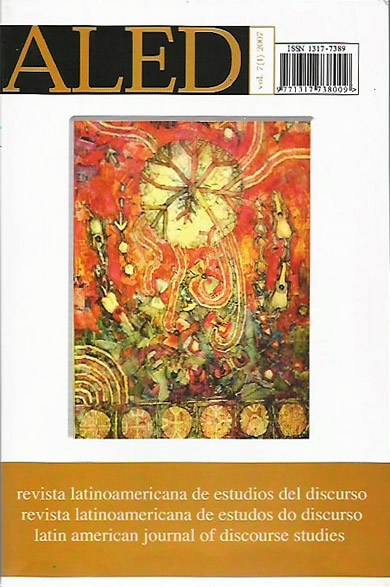Humor en editoriales de TalCual Texto e imagen en el discurso político
Keywords:
sociosemiotics. humor. political discourse. dialogic interaction.Abstract
After exploring different theories and methods for the study of humor in political discourse, I take the challenge of choosing an approach to discourse analysis which defines discourse as multimodal (Gunter Kress, Leite-García and van Leewen, 2000) to study, from a sociosemiotic perspective, editorials taken from the Venezuelan newspaper TalCual, and published from October 2005 to April 2006. The editorials are all related to the topic of corruption, and specifically to the events that took place during that period at the Venezuelan Supreme Court of Justice. From this corpus, and for the purposes of this article, I have chosen an editorial that synthesizes the newspaper’s stand on the problem, and that also establishes an intertextual relationship ”“ both at the iconic and linguistic dimensions”“ with previous editorials. The editorials are placed on the front pages of Tal Cual, in a space fully illustrated with colorful images. I am particularly interested in the relationship established among the images conceived as symbols and the texts with which they dialogize. It is precisely in the intersection of these semiotic resources that humor and, above all, the evaluation of political discourse, are constructed.
Downloads
References
ADAM, J.-M. y BONHOMME, M. (1997). L ´argumentation publicitaire. Rhétoriquede l ´éloge et de la persuasion. Paris: Nathan Université.
BAJTIN, M. M. (1990). La cultura popular en la Edad Media y en el Renacimiento.El contexto de François Rabelais. Madrid: Alianza Universidad. 3ª. ed. Primeraedición en ruso, 1965.
BOLÃVAR, A. (2005). Discurso e interacción en el discurso escrito. Segunda edición.Caracas: CDCH, Universidad Central de Venezuela.
CHARAUDEAU, P. (1992). Grammaire du sens et de l’expression.Paris: HachetteÉducation.
CHARAUDEAU, P. (1997). Le discours d’information médiatique. La construction dumiroir social.Paris: Nathan. Collection Médias-Recherches.
CHARAUDEAU, P. (s/f ). Humour quand tu nous tiens. Essai de définition et decatégorisation du discours humoristique. Trabajo inédito
FIORIN, J. L. (2003). Linguagem e ideología. São Paulo: Ática.
IEDEMA, FREEZ & WHITE (1994). Media Literacy. Sydney: Disadvantaged SchoolsProgram, NSW Department of School Education. Disponible enwww.grammatics.com/ Appraisal/MediaLit-Comment.doc.
KRESS, G. LEITE-GARCÃA, R. y VAN LEEWEN, T. (2000). “Semiótica discursiva”, enT. van Dijk. El discurso como estructura y proceso, pp. 373-416. Barcelona:Gedisa.
PERELMAN, CH. y OLBRECHTS-TYTECA (1989). Tratado de la argumentación. Lanueva retórica. Madrid: Gredos.
VIEIRA, L. D. (2002). “La construcción de la imagen del otro en el discurso irónico”, en L. Molero de Cabeza y A. Franco. El discurso político en lasciencias humanas y sociales, pp. 137-147. Caracas: Fonacit.
VIEIRA, L. D. (2003). “El mundo al revés. Humor en el discurso político”, Revista Latinoamericana de Estudios del Discurso, 3(1) 2003: 83-91.
VIEIRA, L. D. (2005). “¡Ojalá sea él y no un líder anacrónico, pero equilibrado!Acerca de la ironía en la argumentación polémica”, en L. Molero de Cabeza;A. Franco y L. Vieira. Estudios del discurso en Venezuela. Teoría y método, pp.249-258. Barquisimeto: Fonacit.
Downloads
Published
How to Cite
Issue
Section
License

This work is licensed under a Creative Commons Attribution-NonCommercial-NoDerivatives 4.0 International License.
The authors retain the copyright and guarantee RALED the right to be the first publication of the work as well as a Creative Commons Attribution License that allows others to share the work with recognition of authorship and the initial publication in this journal.




